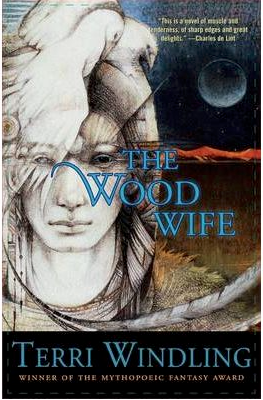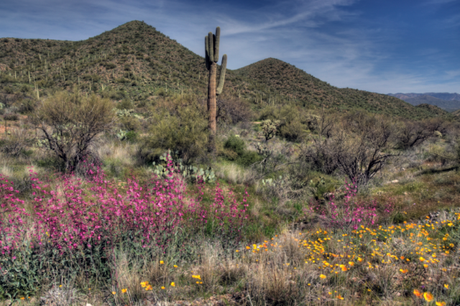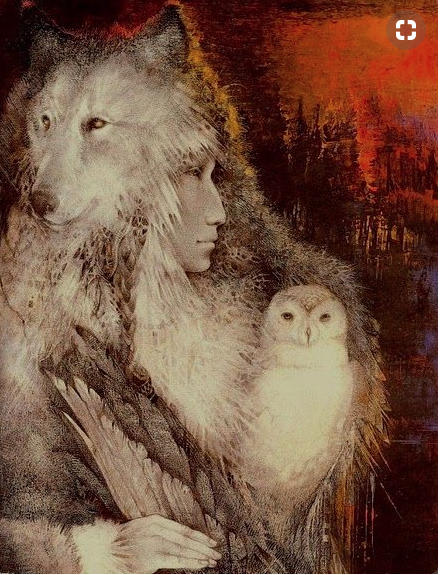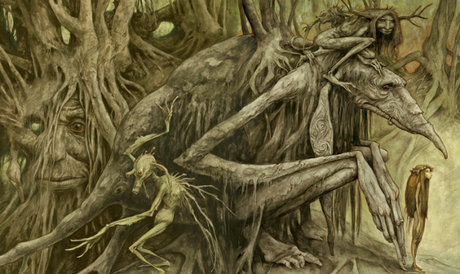
Terri Windling is an American author, editor, artist and essayist. Together with Ellen Datlow she’s edited numerous anthologies of fantasy/speculative fiction short stories. As a writer she’s famous for the use of mythology, folklore, and fairy tales.
Her second novel, The Wood Wife, which was published in 1996, is set in the Sonora desert and tells the story of the poet Maggie Black. Maggie Black has inherited the house of poet Davis Cooper who lived in the Rincon mountains, near Tucson for decades. Cooper was something like a mentor for Maggie and it was always her greatest wish to meet him in person. Unfortunately, this never happened. She’s surprised that Cooper, who was found murdered in the desert, chose her as his inheritor and travels to the Sonora desert with great trepidation. She hopes she’ll be able to write his biography and find out whether, as she suspects, he’s been writing secretly. Officially, Cooper stopped writing a long time ago. Possibly because he didn’t get over the death of his wife, Mexican painter Anna Naverra.
Maggie is used to big cities and coming to a place that’s as remote as Cooper’s house, is a huge challenge. Living there, even more so. Luckily, she finds the people living close by, former friends of Cooper, are very welcoming.
Soon after her arrival, strange things begin to happen. It’s as if the mountain and its fauna has a life of its own. All seems linked to Anna’s paintings and Cooper’s poems. Or is it the other way around? Did the paintings and poems come alive? Maggie embarks on a journey of discovery that is anything but safe.

The Wood Wife is such a haunting, beautiful book for many reasons. The way Terri Windling captures the desert, its flora and fauna is magical, even before she mentions any mythological creatures or folklore. The reader can feel how powerful it is and how it transforms Maggie from the beginning because she’s open to its beauty and wildness. Maggie has left behind a life that wasn’t all success and happiness. She was married to a famous musician who was unfaithful and cost her a lot of energy. In traveling to the Sonora desert, Maggie also hopes to return to her own writing. The connection of art and life and the theme of relationships between artists or between famous and less famous artist are some of the most important elements of this story. The book explores different possibilities and also different views of art.
Here’s Maggie:
I supported my ex-husband all through the lean years at the beginning of his career. I stopped writing poetry and hustled my butt getting every magazine assignment I could. Cooper was furious with me but I wouldn’t listen; I was in love, and ready to join that long tradition of the little woman behind the great man. . . I think I had this romantic vision of being The Artist’s Muse–but instead I was just The Hardworking Wife. And the muses were all the ladies that my husband had on the side.”
And this is Fox:
“You assume that what I want is what you would want: Success, Recognition. I’m not like you. I’m not like Cooper. That’s not what a good life means to me. Playing music is a high, for sure–but there’s other things that I like just as much. Carpentry, for instance; it’s honest work, it’s solid, it’s real, it pays a living wage . . . I give free music lessons to kids . . . I like having time for things like that. And time for my friends. And for myself. I don’t want to spend all my time hustling music. Just want to play it, enjoy it, and have a life.”
The Wood Wife tells, among many things, also a beautiful love story and stories of friendship. The strength of these stories stems from the wonderful, complex characters.

I enjoyed this book very much and read it very slowly. Terri Windling created a magical world that is beautiful but not cute. Life in the desert is harsh. For months it’s dry and then when it rains, everything is flooded and the people living on the mountain are trapped there. Coyotes and rabbits roam freely but they are also hunted by poachers and tourists who think it’s a fun sport. In many ways, this is a very realistic depiction of a landscape and a way of life but then the book goes deeper and uses mythology and folklore to show what a magical, powerful place the Sonora is.
Here’s what Cooper says:
I need a land where sun and wind will strip a man down to the soul and bleach his dying bones. I want to speak the language of stones.
The Wood Wife reminded me of a few European fantasy books, like Diana Wynne Jones’ Fire and Hemlock or Alan Gardner’s The Owl Service. They use European folklore and mythology, in the same way Windling uses North American Indian folklore. The juxtaposition of these two different, yet similar approaches is even addressed in the book.
“I’ve studied Davis Cooper as an English poet. Born and raised in the West Country. So when I read his poems I see English woods, I see the moor, and hedgerows, and walls of stone. And then I drive up here,” she waved her hand at the dry land around them, “and I realize that these are the woods he’s been talking about all along. These hills. This sky. Now I’m reading a whole different set of poems when I look at Cooper’s work.”
The illustration of the book cover shows artwork by Susan Seddon Boulet. Her artwork captures the spirit of Windling’s book. I’ve attached another example of her work above.

In the afterword, Terri Windling writes that she was inspired by the art of British artist Brian Froud. The picture above is one of his Faerie Realm series.
I discovered this book a while ago on Grace’s blog Books Without Any Pictures. You can read her review here.
Those who are interested in mythology, folklore, and fairy tales, might love Terri Windling’s blog, Myth and Moor. The essays are outstanding and the photos so beautiful.
